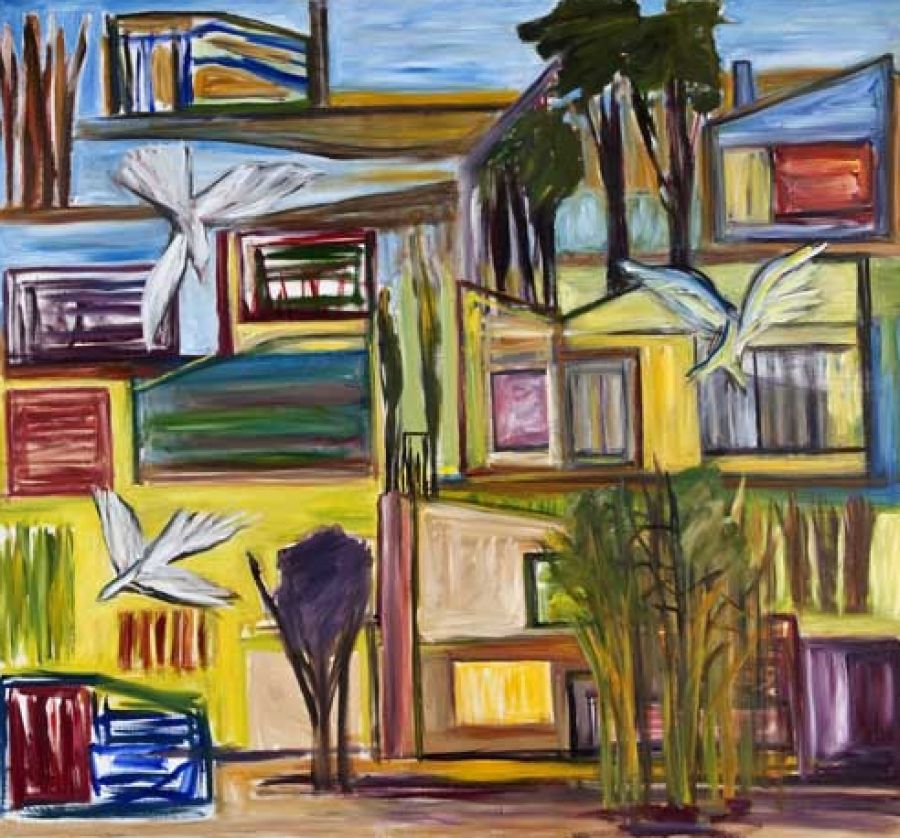
- Free Article: No
- Contents Category: Art
- Review Article: Yes
- Online Only: No
- Custom Highlight Text:
This catalogue accompanies the current exhibition of Ken Whisson’s work at Melbourne’s Heide Museum and, later, at Sydney’s Museum of Contemporary Art. The exhibition and catalogue are a joint exercise by MCA curator Glenn Barkley and Heide’s Lesley Harding. As with most exhibition catalogues, it offers an artist’s statement; a Foreword (by MCA director, Elizabeth Anne Macgregor); a 10,000-word curatorial essay; a list of works; biographical notes, listing Whisson’s exhibitions and the collections that represent his work; a Bibliography, detailing references to Whisson; and Acknowledgments. All of the works in the exhibition are reproduced in thumbnail illustrations, and more than sixty paintings and twenty drawings are reproduced in larger colour plates. Also featured is an interview that Whisson gave to Sydney-based artist (and friend) Joe Frost in 2009. All this comes in a modestly sized catalogue that has been crisply designed by Liz Cox.
- Book 1 Title: Ken Whisson
- Book 1 Subtitle: As If
- Book 1 Biblio: Heide Museum of Modern Art and Museum of Contemporary Art Australia, $35 pb, 175 pp
Much admired, Whisson (who was born in 1927) has been a frequent exhibitor, with an annual show for three decades. Barkley and Harding, presenting Whisson to a new audience, ask ‘Do we really know what Whisson thinks and believes by looking at his pictures?’
Macgregor, in her Foreword, notes that the exhibition title, As If, was suggested by the artist and derives from Immanuel Kant and French surrealists, who exhorted us to live ‘as if the world really exists’. Whisson’s view ‘that art should be outside of the prevailing reality’ makes him hard to pin down. Barkley and Harding’s assertion that ‘meaning and comprehension’ are deeply embedded in Whisson is a truism. One has the sense that Whisson remains elusive. Whisson, a most literary artist, draws on William Faulkner’s belief that art matters when it gives ‘something nearer to the reality that we feel [the world] surely must have, but does not seem to have’. Perceiving what lies beyond the comprehensible is crucial to Whisson.
Edge is central to Whisson; therein lies his appeal. Always uncompromising, he appreciates distance, both in painting and his own life (he has lived abroad since 1976). Avoiding the mainstream, he has maintained a fringe position that allows critical freedom.
The catalogue features a page-long reading list from Whisson. Perhaps more catalogues should do the same, for this one is revealing. Whisson is clearly a deeply conceptual thinker, as his idiosyncratic paintings attest. A voracious reader, his list includes works by authors from Herman Melville to Alexis Wright. Many titles come from John Berger and Georges Duhamel, from whom Whisson says he gained much inspiration and strength.
 Ken Whisson, Imaginary America 1974–75, oil on composition board, 80.7 x 114.6 cm, TarraWarra Museum of Art, Victoria, Gift of Eva and Marc Besen 2001, © the artist.
Ken Whisson, Imaginary America 1974–75, oil on composition board, 80.7 x 114.6 cm, TarraWarra Museum of Art, Victoria, Gift of Eva and Marc Besen 2001, © the artist.
In their survey of Whisson’s work, Barkley and Harding divide their essay into two parts. They begin by outlining Whisson’s artistic development. Their emphasis is largely biographical; they describe the evolution of Whisson’s work in Lilydale and postwar Melbourne. In a section headed ‘Interior Life’, they explain how Whisson wrestled to capture psychological space: ‘what is seen and what is felt.’ Living in St Kilda in the 1970s, Whisson worked in both figuration and abstraction, and consolidated shape-making on masonite panels as an expression of ideas. Then he moved to Perugia in 1977, since when he has painted on canvas.
The second part of the essay explains Whisson’s work in terms of ‘his lexicon of motive and themes’ and technical methodology. Barkley and Harding focus on Whisson’s painting of animal forms and their meaning, and on his fascination with birds, flight, and weightlessness. They might have devoted more attention to Whisson’s remarkable drawings. They conclude that, if Whisson, early in his career, painted ‘small poems of his life’, as Sydney painter Kevin Connor has suggested, then his mature work might be considered ‘as the poetry of a life long lived self-consciously in the first person’.
The essay is clearly written, without the jargon that mars much writing about art. Barkley and Harding allow Whisson to speak as often as possible. A monograph on Whisson having been long overdue, this catalogue is valuable as an introduction to an artist who demands to be studied. It leaves one hungering for more.


Comments powered by CComment